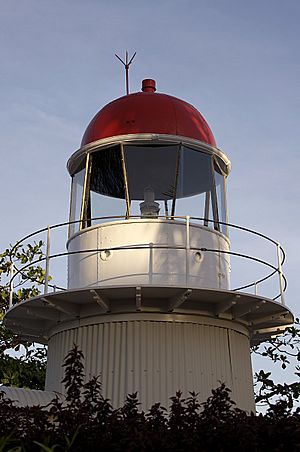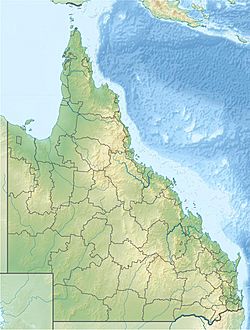Bay Rock Light facts for kids
 |
|
| Bay Rock Lighthouse at the Townsville Maritime Museum | |
|
|
|
| Location | Townsville Queensland Australia |
|---|---|
| Coordinates | 19°15′33.18″S 146°49′26.31″E / 19.2592167°S 146.8239750°E |
| Year first constructed | 1886 |
| Automated | 1920 |
| Deactivated | 1980s |
| Construction | timber frame clad covered by corrugated iron |
| Tower shape | cylindrical tower with balcony and lantern |
| Markings / pattern | white tower and red lantern |
| Height | 8 metres (26 ft) |
| Focal height | 29 metres (95 ft) (original location) |
| Original lens | 4th Order dioptric |
| Admiralty number | K3117 (ex) |
| ARLHS number | AUS-266 |
The Bay Rock Light is an old lighthouse that once stood on Bay Rock. This was a small, rocky island near Magnetic Island, about 20 kilometers north of Townsville, Queensland, Australia. It first shone its light in 1886. Later, it became automatic in 1920 and stopped working in the 1980s. In 1992, the lighthouse was moved to the Townsville Maritime Museum, where you can see it today.
History of the Lighthouse
The Bay Rock Light started guiding ships in 1886. It was first built on Bay Rock itself. Its main job was to help ships find their way to a special quarantine station. This station was on West Point, Magnetic Island. The lighthouse also helped ships enter Cleveland Bay. It guided them to a safe place to drop anchor near Bay Rock.
How the Lighthouse Was Built
The lighthouse was 8 meters (about 26 feet) tall. It had a strong timber frame. This frame was covered with corrugated iron sheets. These sheets were treated to prevent rust.
The Bay Rock Light was one of eight lighthouses built this way. They all had a hardwood frame covered with corrugated iron. Other lighthouses like this included Sea Hill Light, Grassy Hill Light, and Goods Island Light.
The Light Itself
The original light source used Kerosene. It was very bright, shining with an intensity of 1,200 cd. The light stood 29 meters (about 95 feet) above sea level. It showed a special pattern of red and white flashes. This pattern was a group of flashes every six seconds. The white flashes could be seen from 14 nautical miles away. The red flashes were visible from 7 nautical miles away. The original lens was a 4th order dioptric lens. This type of lens uses glass to focus the light.
Lighthouse Keepers
At first, people called keepers lived and worked at the lighthouse. A small cottage was built for the keeper and their family. The last keeper was John Albert Edward Lawson. In March 1920, John Lawson was sadly lost at sea. His small fishing boat overturned.
Because of this accident, the lighthouse was changed to work automatically. It no longer needed a keeper. In 1920, the light was updated to an automatic acetylene gas burner. This meant it could run on its own.
Deactivation and Replacement
During the 1980s, the Bay Rock Light was turned off for good. A smaller, modern fiberglass beacon replaced it. This new beacon is still active today. It shows two white flashes every eight seconds.
Moving the Lighthouse
In 1992, the old lighthouse was moved. It found a new home at the Townsville Maritime Museum. An emergency services helicopter helped move the top part of the lighthouse. Queensland Transport helped restore the lighthouse. It was officially opened to the public in September 2003.
Visiting the Lighthouse Today
You can visit the Bay Rock Light at the Townsville Maritime Museum. The museum is located on the south side of Ross Creek in Townsville. It is open daily, and there is a fee to enter.




